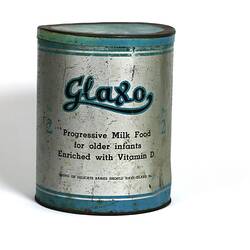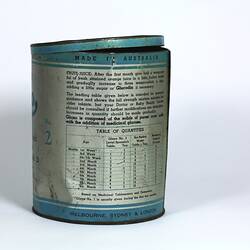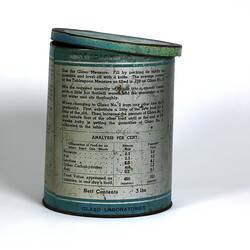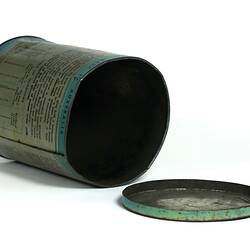Summary
Empty tin that originally contained Glaxo number 2 formula, made in Australia by Glaxo Laboratories, circa 1930-1959. Its contents were probably consumed in Victoria, Australia, and the empty tin was used to store flour.
Glaxo originated as 'Defiance' in 1904 in a small dairy in Bunnythorpe, New Zealand, by the Nathan family. The expanding business was partly managed from England, where some of the Nathan family was based. Glaxo was introduced to Australia around 1912. In Janurary of that year the Adelaide Daily Herald announced that 'We have received from Messrs. D. and J. Fowler a tin of Glaxo, an infants' and invalids' food. This line, which has had a large sale in Europe for some time, but is only now being introduced into the Australian States, is made simply, by the addition of boiling water, and is a food for old and young, invalids and healthy. The above-mentioned agents have charts showing the progress of thirty infants raised on this food, together with testimonials from Europe, which are undoubted. Glaxo is made' from pure cows' milk, and one quarter of it is pure butter fat, which is the most nutritious element that babies can possibly have in their good as it strengthens the constitution against those ailments so common to babyhood. It is also the nearest milk to mothers' that it is possible to obtain.' (15 Jan 1912).
Glaxo quickly increased in popularity, particularly with the onset of World War I. Cases of Glaxo were supplied to soldiers serving in Egypt and elsewhere through organisations such as the YMCA and the War Chest. At home, as shortages of milk began to bite, Glaxo was advertised as 'germ-free, and more nourishing and digestible than ordinary cows milk. Glaxo contains over 25 per cent of pure butter fat. It is valuable at any time, but much more so now that milk is scarce.' (Maryborough Chronicle, Queensland, 13 Dec 1915)
Later in the war years, Glaxo sometimes used anxiety about the conflict to appeal to mothers: 'GLAXO builds Bonnie Babies - Bonnie Babies build Bonnie Soldiers - Bonnie Soldiers built the British Empire. But, to-day, our Empire, homes, and babies are in danger. Germany would wreck Britain and Australia as callously as she wrecked the "Lusitania"...babies the world over cry out to our manhood for protection from the ravages of Prussian hordes. THE EMPIRE NEEDS BONNIE SOLDIERS. Be a worthy son of the best Mother and greatest Empire the world ever knew. Be a brother-a member of the noblest brotherhood ever created-brothers-in-arms! Be an avenger of innocents - a protector of the helpless. Every man who loves his Empire, home, and baby is needed. Be a Bonnie Soldier - Protect Your Bonnie Babies!' (Sydney Morning Herald, 24 May 1917)
Physical Description
Circular tin with separate lid. Tin painted silver with light blue bands along lower and upper edges. Front surface decorated with brand name and logo. Back surface covered in extensive text in black ink. Lid undecorated and painted blue.
More Information
-
Collecting Areas
-
Acquisition Information
Donation from Mrs Doris Ethel Griffiths, Jul 1991
-
Manufacturer
Glaxo Laboratories, Australia, 1930-1960
Date based on appearance -
Place Used
-
Inscriptions
Printed, front: GLAXO/PROGRESSIVE MILK FOOD/ FOR OLDER INFANTS/ENRICHED WITH VITAMIN D/YOUNG OR/DELICATE BABIES SHOULD HAVE GLAXO NO. 1.
-
Classification
-
Category
-
Discipline
-
Type of item
-
overall dimensions
15.5 cm (Length), 15.5 cm (Width), 19.5 cm (Height)
-
References
EQUITABLE ASSURANCE COMPANY. (1912, January 15). Daily Herald (Adelaide, SA : 1910 - 1924), p. 4. Retrieved February 10, 2015, from [Link 1] THE "WAR CHEST" FUND. (1915, October 23). The Sydney Morning Herald (NSW : 1842 - 1954), p. 18. Retrieved February 10, 2015, from [Link 2] Advertising. (1915, December 13). Maryborough Chronicle, Wide Bay and Burnett Advertiser (Qld. : 1860 - 1947), p. 6. Retrieved February 10, 2015, from [Link 3] Infant Feeding Practices - a Cross-cultural Perspective, ed. Pranee Liamputtong, Springer, 2011, p.252 Advertising. (1917, May 24). The Sydney Morning Herald (NSW : 1842 - 1954), p. 4. Retrieved February 10, 2015, from [Link 4] GlaxoSmithKleine history, [Link 5] accessed 10 Feb 2015 Glaxo: a History to 1962. R. P. T. Davenport-Hines and Judy Slinn, CUP, 2012 'The business of medicine, a history of Glaxo', reviewed by A.J. Smith in [Link 6] accessed 10 Feb 2015
-
Keywords





